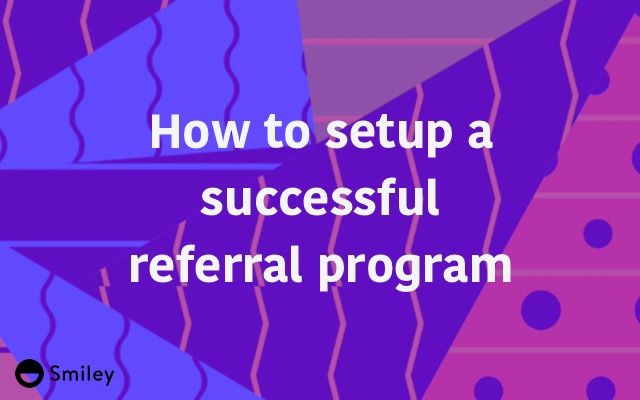How to Setup a Successful Referral Program

According to Nelson, 92% of respondents trusted referrals from people they knew, so it’s no surprise that almost all local businesses agree that word-of-mouth marketing is the most powerful way of acquiring customers. A recent national poll conducted by Alignable showed that 85% of local businesses view word-of-mouth as the best way to reach and acquire local customers.

Moreover, referrals don’t just bring any customers; they tend to bring the best customers. Your loyal customers are more likely to refer your service to others, and when they do, they know exactly who among their friends and families, really crave your service. According to the Wharton School of Business: The Lifetime Value for new referral customer is 16% higher than non-referrals.
Therefore, it is vital to put word-of-mouth marketing as an essential part of your marketing strategy. However, word-of-mouth marketing may sound simple, but it isn’t. Referral programs have many different moving parts, and it’s easy for busy merchants to get stuck when setting up.
To leverage the power of word-of-mouth marketing, we need concrete plans. A carefully designed referral process can provide a steady stream of new highly qualified customers. Here are a few steps toward building this system.
Deliver exceptional product and service
First of all, delivering exceptional product and service is undoubtedly the first step in creating a successful referral program. But how do you ensure that your product is outstanding? No, you don’t have the answer, your customers do.
You can conduct customer surveys regularly to learn about what your customers think. The Net Promoter Score (NPS) survey is perfect for doing just that. NPS survey asks on a scale of 1 to 10 how likely your client will recommend you to others. Follow up with a question on why the customer chooses the score.
This simple survey can deliver significant insights into your business. So higher NPS indicates that more of your clients are satisfied with what you are offering and are willing to recommend you to others.
Customers who give 9 or 10 are your promoters. They are you loyal brand advocates. Your best customers. Knowing what makes them love you helps understand your strength. On the other hand, customers who give a score below 7 are your detractors. They won’t recommend you for some reason. You should find out why. Learning what they dislike about helps you gain insights into the weakness of your business and how to improve. Treat every negative response as an opportunity to learn.
What kind of offers to give
Now you have a way to ensure that you provide exceptional service. And by utilizing NPS surveys, you should have an idea what kind offers to use for your referral program.
The most effective referral setup we’ve seen offer double-sided rewards. Companies such as Uber, PayPal, Dropbox all utilized this kind of referral program to achieve exponential growth.
A double-sided referral program not only rewards the invited customer but also gives incentive to the person who successfully refers a new client. Rewards are usually in the form of discounts for your services.
You may see referral incentives as a financial cost, but you only give them when a referral succeeds. Also, not only will you gain a new customer, your existing customer is likely to make another purchase after receiving the reward.
Don’t shy away from large offers! Remember that it is 7X more expensive to convert a new customer than an existing customer. That alone should justify the rewards given for successful referrals.
Why you should ask for referrals
According to Texas Tech, despite 83% of customers report they’d refer a business to friends and family following a positive experience, only 29% actually do. It’s more likely that they just forget about it or it just didn’t cross their mind during their conversations.
That is one of the reasons why you should ask for referrals. Since your customers are willing to make referrals already, your job should be reminding them to do so. Better yet, if you have set up referral rewards, you now have more reasons to ask them for referrals: they get rewarded for doing something they are willing to do!
Even better, if you are a Smiley customer, our referral system automatically sends an SMS message asking for referrals after they’ve completed an NPS survey and given a promoter score.
Make it effortless to share!
Successful referral programs make it easy for customers to tell others about you and accelerate the rate of new customers coming into the store via referrals.
Technology advances have changed how people are connected in every aspect of their lives. People are always texting each other, interacting on social media sites like Facebook and Twitter.
As a result, it is vital for businesses to utilize these digital channels as a vehicle to bring in new customers. What’s a better way to have your customers share referrals on social media or via SMS text messages! Smiley’s referral system help your customers easily share a personalized referral page to their friends and families on social media or via SMS.
Conclusion
In conclusion, local businesses understand the power of word-of-mouth marketing but implement one requires careful plans. Making sure you are providing exceptional product and service is the prerequisite to setting up a referral program. Using double-sided referral rewards, crafting appealing offers that your customers crave, as well as making it effortless for customers to send referrals are all necessary steps toward running a successful word-of-mouth marketing.
If you need help setting up a referral system, contact us for a FREE demo.
References
- https://referralrock.com/blog/referral-programs-101-everything-you-need-to-build-a-referral-marketing-program/#work
- https://smallbiztrends.com/2014/06/small-businesses-get-customers-through-word-of-mouth.html
- https://faculty.wharton.upenn.edu/wp-content/uploads/2013/05/Schmitt_Skiera_VandenBulte_2013_Referrral_Programs_2.pdf
